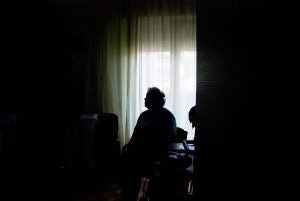 Original editorial published in The Prince Albert Daily Herald on October 7, 2020.
Original editorial published in The Prince Albert Daily Herald on October 7, 2020.
The COVID-19 pandemic has sounded the alarm on the state of long-term care in Canada.
Canadians have been horrified to learn that four out of five lives lost due to COVID-19 have been residents or workers in long-term care facilities – the worst record in the developed world. A report from the Canadian Forces, who were deployed to help manage outbreaks in several care homes, put into gruesome detail just how deep the crisis in long-term care had become, and sent shockwaves across the nation.
While the public is mostly just waking up to this reality, if you ask one of the thousands of CUPE members who work in long-term care in Saskatchewan, they will tell you that this crisis isn’t new. They will tell you that this crisis has been brewing for years. They will tell you COVID-19 fell like an avalanche onto a system that had already been broken and left totally unprepared by decades of underfunding and understaffing.
The election on October 26 is our best chance to reverse course and fix long-term care. Seven months after the novel coronavirus arrived, there’s no longer any excuse for being unprepared, and there’s no excuse for continued inaction.
For years, our union has been calling for urgent action to fix long-term care here in Saskatchewan, while the Sask Party under different leaders did the opposite, and cut long-term care to the bones.
It’s been shown time and time again that public, not-for-profit long-term care beds provide the best quality care at the best cost while also paying workers who care for residents a liveable wage. Relative to the rest of Canada, Saskatchewan has a decent number of public, not-for-profit long-term care beds, but they have been in decline since the Sask Party took office in 2007. Private, for-profit care has been encouraged by the Sask Party, nearly doubling since 2004, where residents face monthly fees of up to $6,000 for lower levels of care than what is provided in a public, not-for-profit setting.
The Sask Party has left the physical infrastructure of long-term care facilities to rot to the point that facilities in Grenfell and Regina have been forced to permanently close. And it’s the expensive, for-profit options that are left to fill the gaps.
To make things worse, in 2011, the Sask Party axed rules that required at least two hours of personal care per day per resident. To put that into perspective, most experts agree that long-term care residents should receive a minimum of 4.1 hours per day of hands-on care – but our seniors in Saskatchewan today aren’t even guaranteed two.
In 2019, the Saskatchewan Health Authority painted a bleak picture in its survey of long-term care facilities: critical staffing shortages and burnout, delayed responses to call bells, and residents unable to get more than one bath a week. And that was before COVID-19 struck.
We know what it will take to fix long-term care – because we’ve been telling this Sask Party government for years.
We need a major increase in the number of public long-term care beds and urgent repair of our long-neglected long-term care infrastructure.
We need regulations that guarantee a minimum of 4.1 hours of hands-on care per resident every day.
We need to boost staffing levels in order to reduce staff burnout and improve the quality of care for residents.
We need to make long-term care jobs stable and full-time, so that workers do not have to work second or third jobs, putting residents and other staff at more risk during a pandemic.
Everyone in Saskatchewan knows someone who lives or works in a long-term care home. On October 26, let’s remember them when we go to the voting booth, and elect a government that will make these life-saving solutions a reality.
Mark Hancock is the National President of the Canadian Union of Public Employees (CUPE). Judy Henley is the President of CUPE Saskatchewan. CUPE represents over 13,000 health care workers across the province.
/cope342
RELATED:
